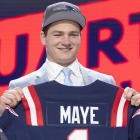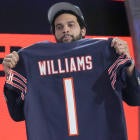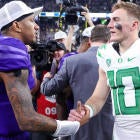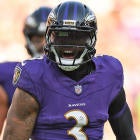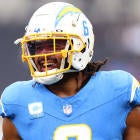Abraham Lincoln once said: "He who represents himself has a fool for a client." The 16th President of the United States was referring to the legal profession with his statement. The sentiment could just as easily apply to the sports-representation industry.
Cornerback Richard Sherman defended the three-year contract worth up to $39.15 million he recently negotiated with the 49ers after being released by the Seahawks in an article he wrote for the Players' Tribune and at his introductory press conference on Tuesday. The four-time All-Pro, who ruptured his right Achilles during the middle of the 2017 season, expressed frustration with the criticism he has received after negotiating a contract that has been described as extremely team friendly. Newly-retired Joe Thomas, a future Hall of Fame left tackle, isn't impressed with Sherman's negotiation skills. He thinks Sherman "got absolutely crushed" by the 49ers.
Sherman deflected the criticism in the press conference by singling out the five-year, $40 million contract linebacker Nigel Bradham just signed to remain with the Eagles as the type of bad deals negotiated by agents that aren't similarly disparaged because of a lack of guaranteed money. He characterized Bradham's deal as one-year, $6 million contract. There's actually $8 million fully guaranteed with an additional $6 million in 2019 conditionally guaranteed. The deal could ultimately be for only one year because there aren't any significant salary-cap consequences for Philadelphia parting ways with Bradham after the 2018 season.
Sherman makes a valid point about the double standard. His deal was always going to be heavily scrutinized, at least by the agent community, because of his previous dismissiveness of an entire profession while asserting that players without any experience could do a better job negotiating contracts. As one of his main qualifications for going without an agent, Sherman touted his study of contracts for less than two of an average person's full workdays prior to representing himself.
Sherman contract breakdown
Signing bonus: $3 million
Fully guaranteed at signing: $3 million
Potential guarantee: $19 million
Base value: $27.15 million
Maximum value: $39.15 million
Contract length: 3 years
Year | Base salary | Roster bonus | Per game roster bonus | Workout bonus | Signing bonus proration | Salary cap number |
2018 | $2,000,000 | $2,000,000 | $2,000,000 | $50,000 | $1,000,000 | $6,175,000 |
2019 | $7,000,000 | $2,000,000 | $50,000 | $1,000,000 | $10,050,000 | |
2020 | $7,000,000 | $2,000,000 | $50,000 | $1,000,000 | $10,050,000 |
The base value of Sherman's deal is considered to be $27.15 million over the three years, although the per-game roster bonuses are treated as incentives under the salary cap. The $2 million of annual game-day active roster bonuses ($125,000 per game) are considered a part of the $27.15 million. Since Sherman wasn't active for the final seven games of the 2017 season, there isn't an initial cap charge for $875,000 of the $2 million in 46-man active roster bonuses for 2018.
The other $2 million roster bonus is contingent on Sherman recovering from his Achilles injury. He gets the $2 million as long as he can pass the 49ers' physical exam by the day after games for the 11th week of the regular season are played, which is Nov. 20.
Sherman has a total of $12 million in performance bonuses: $3 million is tied Sherman's playing time, $3 million is for making the Pro Bowl and an additional $6 million is for All-Pro honors.
Sherman gets $1 million annually for each Pro Bowl selection. In order to cash in on the Pro Bowl bonus, Sherman must be selected on the original ballot and participate in the game unless medically excused or playing in the Super Bowl. Getting into the game as an alternate doesn't meet the requirements for payment. Ninety percent or more defensive playtime in a season is necessary to qualify for a $1 million incentive in each contract year. Being named first- or second-team All-Pro by The Associated Press, Pro Football Weekly, the Pro Football Writers Association, Sporting News or Sports Illustrated is worth $2 million annually.
The most complicated part of Sherman's contract relates to his potential salary guarantees. Making the Pro Bowl in 2018 will increase Sherman's 2019 base salary by $1 million to $8 million and trigger an injury guarantee for the amount the day after Super Bowl LIII (Feb. 4, 2019). The $8 million becomes fully guaranteed less than two months later in April. The $2 million in per-game roster bonuses reduces to $1 million ($62,500 per game) with the increase in Sherman's base salary.
A similar mechanism applies in 2020. Sherman being selected to the Pro Bowl in 2019 increases his 2020 base salary by $1 million, to $8 million. An injury guarantee is once again triggered the day after the Super Bowl (Feb. 3, 2020). April 1 is when the $8 million is fully guaranteed. The $2 million in per-game roster bonuses reduces to $250,000 ($15,625 per game) where Sherman's 2020 base salary is $8.75 million with Pro Bowl selections in both 2018 and 2019. The escalation of Sherman's 2020 base salary to $8.75 million also voids the $1 million playtime incentive for the 2020 season. A Pro Bowl selection only in 2019 lowers the per-game roster bonuses for 2020 to $1 million, just like in 2019, with the other $8 million as base salary.
What Sherman should have done
Sherman has proclaimed that there isn't an agent that could have done a better job negotiating his contract than he did. Actually, the opposite is closer to the truth. No competent agent would ever agree to the exact deal Sherman did, especially in its original form. Sherman should be extremely grateful to the NFLPA for getting the 49ers to move the deadline in his $2 million roster bonus for passing the physical from the third day of training camp, which is in late July or early August, to the latter part of November.
Generally, Sherman is taking too much risk without enough reward in his contract. Although Sherman didn't want to do a one-year deal, he really should have.
Most competent agents would rather do a one-year deal with a player coming off a serious injury than an extremely team-friendly longer contract. The player would be in position to sign a more player-friendly contract at his true market value the following year, provided he played at or close to same level as prior to his injury.
That's what Brent Grimes did in 2013 after tearing his Achilles in the 2012 season opener with the Falcons, when he was playing under a franchise tender. Grimes took a one-year, $5.5 million deal from the Dolphins the next season. After earning a Pro Bowl berth in 2013, he signed a four-year, $32 million contract with $16 million fully guaranteed when the salary cap was $133 million. This deal, which Grimes first played under at the age of 31, averages approximately $10.75 million per year after being adjusted to the current $177.2 million salary cap. Grimes is a good, undersized cornerback who has never been in the conversation of the game's best cover man, like Sherman has.
Should Sherman bounce back from his injury, like Grimes did, he will be underpaid even if he earns the maximum $39.15 million in the deal by hitting his not-so-easily achievable incentives. Darrelle Revis' history might be a good indicator for what could have been in store for Sherman. In 2014, Revis signed what was essentially a one-year, $12 million contract with the Patriots after the Bucs cut him following a subpar 2013 season (by his standards) in which he was returning from a torn ACL. At 30, which is Sherman turns in a few days, the Jets signed Revis to a five-year contract in 2015 where he made $33 million over two years before getting released in 2017.
Sherman should have insisted on some sort of mechanism where the contract would void, if he wasn't going to seriously consider a one-year deal. Making the Pro Bowl in 2018 would have been an appropriate achievement to trigger the voiding of his 2019 and 2020 contract years. The leverage would shift into his favor for the 49ers to retain him with another Pro Bowl berth under his belt, or he could face getting a franchise tag after the season. The cornerback number in 2019 could be approaching $16 million.
Sherman's injury guarantees are inadequate. The Pro Bowl is announced in the latter part of December, while games are still being played. Since the injury guarantee doesn't vest until early February, Sherman could be in a position where he regains his old form, suffers a serious injury either before the regular season ends or in the playoffs, and the 49ers could release him with just a $2 million cap charge from his the signing bonus proration in his 2019 and 2020 contract years. It's also problematic that the injury guarantee in 2020 is completely dependent on Sherman's 2019 performance.
Ideally, Sherman's injury guarantee for 2019 and 2020 would be triggered as soon as he passed a physical for the 2018 season. The outside date should have been when he appears in a 2018 regular-season game. Once his existing injury is no longer a concern, he should have had the same protection as any other 49ers players with an injury guarantee after the first contract year.
Borrowing from Peyton Manning's Broncos contract regarding his neck injury could have been a fallback position to the other suggested improvements of the guarantee. The injury guarantee in Manning's 2014 contract year would have voided with a re-injury of his neck in the 2013 season. This concept could have been applied to Sherman's Achilles if necessary.
There isn't anything Sherman could have done with the April 1 date for the full guarantees. It's later than practically every other NFL team but standard in 49ers contracts.
Any contract Sherman signed with the 49ers was going to have per-game roster bonuses. All of their lucrative veteran contracts have them. Given that Sherman is coming off a serious injury, $2 million in the first contract is understandable. The amount should have automatically been much smaller in 2019 and 2020. For example, wide receiver Pierre Garcon signed a five-year, $45 million contract in 2017 as a free agent with annual per roster bonuses totaling $250,000.
Most of the thresholds for Sherman's incentives aren't easy to reach. Too much money ($9 million total) is tied to honors. An NFC Pro Bowl berth isn't as easy as it was when Sherman was selected for four straight years (2013-2016). Pro Bowl caliber cornerbacks Marcus Peters and Aqib Talib leaving the AFC in trades to the Rams increased the competition. Saints cornerback Marshon Lattimore, the NFL Defensive Rookie of the Year, is another player Sherman wasn't contending with when he was selected. Cardinals cornerback Patrick Peterson is more a Pro Bowl fixture than Sherman. Grimes (Buccaneers), Xavier Rhodes (Vikings), Darius Slay (Lions) and Desmond Trufant (Falcons) also have Pro Bowl pedigrees.
It isn't unheard of for two cornerbacks from the same team to be selected to the Pro Bowl. It happened last year with the Jaguars tandem of A.J. Bouye and Jalen Ramsey. Broncos cornerbacks Chris Harris and Talib made it together in 2014, 2015 and 2016. All-Pro honors are even more difficult since those are usually reserved for just four or five cornerbacks.
Sherman could still be a very good cornerback, who is worth more than $9 million per year, without going to the Pro Bowl; $9 million per year is considered good second-cornerback money.
A 90-percent threshold for playtime is a pretty high bar but it isn't excessive for a starting cornerback. Sherman's cumulative playtime for the five seasons prior to his injury was 96.6 percent.
Sherman should have tried to tie some of the honors incentive money to his individual statistical achievement and/or the 49ers improving in major statistical defensive categories. One of the contracts Sherman mentioned that he studied was cornerback Nnamdi Asomugha's big free agency deal with the Eagles, signed in 2011. Sherman probably should have looked at the much more modest, incentive-laden contract Asomugha signed with the 49ers in 2013 after Philadelphia released him. He had an incentive for interceptions in addition to ones for his playtime.
Sherman has averaged three interceptions a season since leading the NFL with eight in 2013. Payment beginning with four interceptions and increasing for each additional two inceptions wouldn't have been unreasonable. The amount earned doubling with a playoff berth was in Asomugha's contract and is something the 49ers have done for other players.
The 49ers ranked near the bottom of the league in several conventional statistics that measure pass defense. It may have made sense for a portion of the honors money to shifted into an incentive requiring Sherman to play at least a specified number of San Francisco's defensive snaps (at the least 65 percent?) while there's an improvement in ranking from the 2017 season in points allowed, interceptions or average yards given up on passing plays.
Sherman's base salaries increase with Pro Bowl selections. He doesn't have a true escalator because of a corresponding reduction in the per-game roster bonuses. The incentive money earned should be additional dollars instead of only triggering a reclassification of compensation. For example, the $1 million for a 2018 Pro Bowl selection increases Sherman's 2019 salary to $10 million total, but does the same for his 2020 salary. A second Pro Bowl berth in 2019 would raise Sherman's 2020 salary from $10 million to $11 million with this compounding type of salary escalator.
Final thoughts
Some Monday morning quarterbacking is being engaged in with the critique of Sherman's contract. In all fairness, it could be done with any number of deals negotiated by agents.
As a Stanford graduate, Sherman is definitely intellectually capable of negotiating a contract for himself comparable to what a competent agent would have done. It was always going to be a tall order, because representing athletes and negotiating playing contracts is a profession where someone can't become an expert with a proper understanding of the nuances of the deals after just several hours of study.
Chargers offensive tackle Russell Okung navigated free agency in 2016 and 2017 without an agent. He had the foresight to have an experienced industry professional, J.I. Halsell, serve as an advisor. Halsell has worked on both the team and agent side of the business.
Sherman saves, at the most, $904,500 in agent commissions by negotiating his own deal. The maximum fee that an agent can charge under the NFLPA's agent regulations is three percent of a negotiated contract. In some instances, it's less because the default fee in the required Standard Representation Agreement that both agents and players must sign was lowered to one-and-a-half percent last year .A commission can't be collected for any honors incentives that a player earns. In Sherman's case that's up to $9 million, which would have been exempted with an agent agreeing to the Pro Bowl and All-Pro bonuses he did.
We'll never know for sure, but Sherman's decision to do his own deal may have been pennywise and pound foolish because of the potential value a shrewd, seasoned negotiator should have been able to add to the equation. A savvy agent probably would have scheduled a trip across the Bay Area with the Raiders for the following day to put the 49ers at risk in an effort to force them to put their best foot forward in negotiations.













